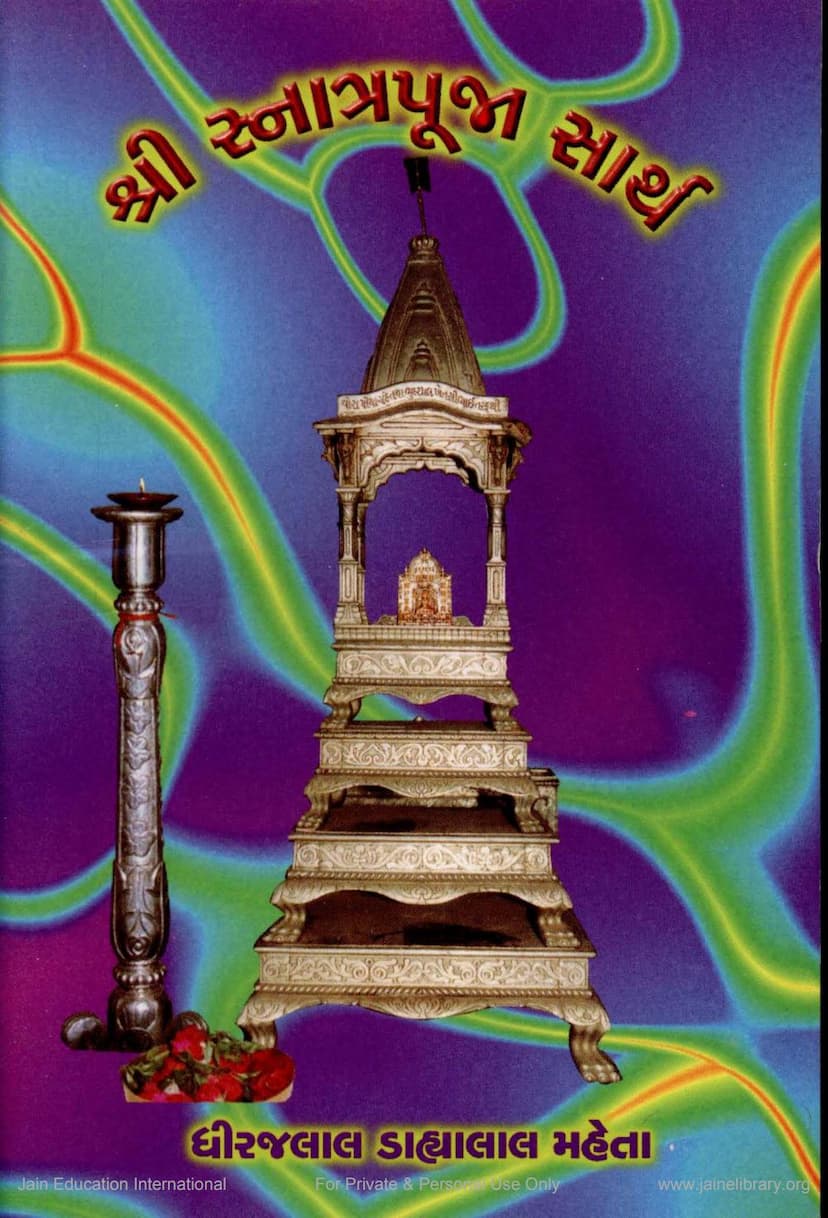Snatrapooja Sarth
Added to library: September 2, 2025

Summary
Here's a comprehensive summary of the Jain text "Snatrapooja Sarth" by Virvijay, translated from the provided Gujarati text:
Title: Snatrapooja Sarth (with explanations) Author: Pt. Shri Virvijayji M. Sa. Publisher: Jain Dharm Prasaran Trust, Surat Catalog Link: https://jainqq.org/explore/001254/1
Overall Purpose: This book is a detailed explanation and guide to performing the "Snatra Pooja," a significant Jain ritual. The Snatra Pooja commemorates the divine birth of Jain Tirthankaras (Jinas), specifically their consecration (Abhisheka) on Mount Meru by celestial beings, as described in Jain scriptures. The text aims to guide devotees in performing this pooja for self-welfare and spiritual benefit.
Key Content and Structure:
The book is structured as a step-by-step manual for conducting the Snatra Pooja, incorporating prayers, verses (dohas, gitas, chands), and rituals.
-
Introduction and Publisher's Note (Pages 2-3):
- The book is published by Jain Dharm Prasaran Trust, Surat.
- It is the third edition, published in 2002.
- The publisher expresses joy in releasing this publication, which describes the Janmabhishek (birth consecration) performed by gods and goddesses on Mount Meru during the birth of the Tirthankaras.
- The aim is for all members of the Jain community (Sangh) to perform this pooja and attain spiritual welfare.
- It mentions the price and contact details for obtaining the book.
-
Pre-Pooja Rituals (Page 4):
- Setup: Describes the placement of three beautiful thrones (bajoth) facing east or north or the main idol. A throne with a saffron swastika and rice grains, topped with a coconut, is placed in the center.
- Kalash (Water Pots): Four kalash, tied with sacred thread and filled with Panchamrita (a mixture of milk, yogurt, ghee, water, and sugar), are placed on another throne with four swastikas.
- Idol Placement: The main idol of the Tirthankara (Pratimaji) is consecrated on the central throne, after marking it with a saffron swastika, filling it with rice, and placing a silver coin. Three Navkars are recited.
- Siddhachakra: The Siddhachakra (a sacred diagram in Jainism) is placed in front of the idol.
- Lamp: A ghee lamp is placed to the right of the idol, as high as its nose.
- Initiation: Those performing the pooja (Snatriyas) tie sacred thread on their hands, hold a kalash filled with Panchamrita, recite three Navkars, and begin.
-
The Snatra Pooja Verses and Rituals (Pages 5-44):
- Invocation and Offering Flowers (Kusumanjali): The pooja begins with verses praising the Jinas. The act of offering flowers (Kusumanjali) is a central part, performed at various points. Specific verses describe the offerings of flowers, their fragrance, and the devotion of gods and humans.
- References to Tirthankaras: The text mentions several Tirthankaras like Shantinath, Neminath, Parshvanath, and Veer (Mahavir), offering flowers at their feet.
- Praise of Holy Places: Verses about Shatrunjaya (Siddhachal) are included, emphasizing its sanctity and the spiritual benefits of taking steps towards it.
- Chaitya Vandan (Salutation to Temples/Idols): This section includes prayers and verses for circumambulating and saluting the Tirthankara's idol, such as the "Jagadchintamani Jagannath" verse.
- Praise of Jinabimbas and Sadhus: Prayers are offered to all Jinabimbas (Jain images) across the universe and to all Sadhus (monks) in Bharata, Airavata, and Mahavideha regions.
- Namotthuṇam Sutra: This is a highly revered Jain scripture for salutation and praise of the Arihants. The text provides its meaning in detail.
- Javanti Cheiyai Sutra: A prayer to all Jain temples and idols.
- Uvassaggaharam Stavan: A praise of Lord Parshvanath, known for removing obstacles.
- Jaya Viray Sutra: A prayer praising the Vitaraga (one who has conquered passions) Tirthankaras.
- Ashta Prakari Pooja (Eight-Fold Worship): The text details the worship with eight substances: Jala (water), Chandan (sandalwood), Pushpa (flowers), Dhup (incense), Deep (lamp), Akshat (unbroken rice), Naivedya (offering of food), and Phala (fruit). Each offering is accompanied by a descriptive verse (Doha) and a mantra.
- Lun Utaran (Removing Salt): A ritual where salt is offered into a flame using water, symbolizing the burning away of negative karma.
- Aarti and Mangal Deep: The pooja concludes with Aarti (waving of lamps) and the Mangal Deep (auspicious lamp) ceremony, followed by prayers for universal well-being.
- Shanti Kalash and Brihad Shanti: A ritual involving a blessed kalash (water pot) and the chanting of "Brihad Shanti" mantras for peace and prosperity. The text provides the meaning of these powerful peace chants.
- Descriptions of the Divine Birth (Janma Mahotsav): Detailed descriptions are given of the celestial events surrounding a Tirthankara's birth:
- The shaking of Indra's throne.
- The arrival of celestials with their musical instruments and offerings.
- The bathing (Abhisheka) of the divine child on Mount Meru by the gods using various sacred waters and substances.
- The number of kalash and the scale of the divine ceremony.
- The role of different celestial beings and the description of the joy and reverence.
- Praise of the Author: The text concludes with verses praising the lineage of gurus and specifically mentioning Pandit Shri Virvijayji M. Sa. as the author who composed this auspicious celebration of the Jina's birth.
Key Themes and Concepts:
- Devotion (Bhakti): The entire text emphasizes sincere devotion to the Jinas.
- Purity and Auspiciousness: The rituals focus on cleanliness, purity of intent, and the creation of an auspicious atmosphere.
- Karma and Liberation: The pooja is presented as a means to shed karmic obstacles and move towards liberation (Moksha).
- Spiritual Welfare: The ultimate goal is the well-being and spiritual progress of the devotee and the entire Jain community.
- Divine Grace: The narrative highlights the divine power and grace that are invoked during such auspicious occasions.
- Adherence to Scripture: The text consistently refers to scriptural descriptions and traditions, emphasizing the importance of following the established practices.
In essence, "Snatrapooja Sarth" is a devotional guide that meticulously details the Snatra Pooja, allowing followers to connect with the divine stories of the Tirthankaras' births and perform a ritualistic act of worship and spiritual purification.